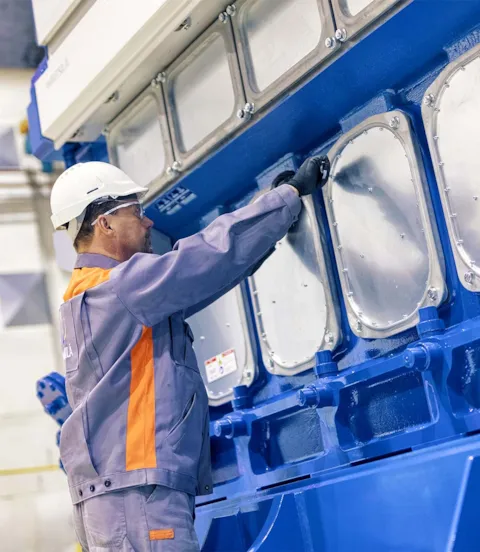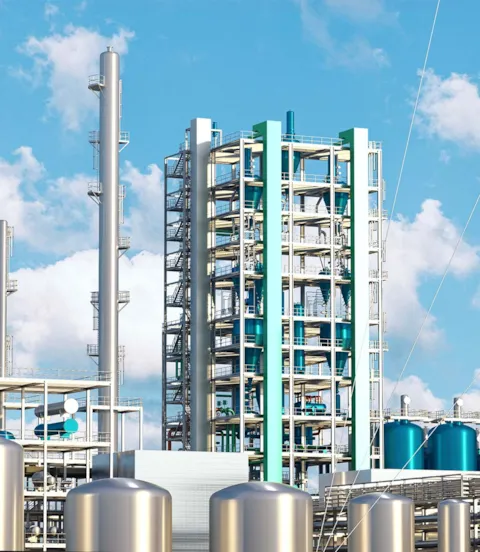What are the total costs of ownership for different methanol-fuelled containership designs?
The chapter on methanol in DNV’s Alternative Fuels guidance paper has been updated to include various engineering aspects as well as a detailed commercial case study for a methanol-fuelled 5,500 TEU containership.
The DNV guidance paper “Alternative Fuels for Containerships”, which is available online, is continuously updated to reflect the latest insights, experiences as well as technology and regulatory developments. In a recent amendment to the chapter on methanol, DNV has added new technical information regarding potential fuel tank arrangements and bunkering, as well as a new section that discusses the business case for a methanol-fuelled 5,500 TEU containership operating in transatlantic trade between Europe and North America.
Steep increase in orders for methanol-powered vessels
According to the February statistics available from DNV’s Alternative Fuels Insight (AFI) online hub, there were 267 confirmed methanol-fuelled ships in operation or on order, most of them in the container segment (169). “In 2023, methanol emerged as the leading alternative fuel option, securing the highest number of ship orders, totalling 138 (excluding methanol carriers),” revealed Jan-Olaf Probst, DNV’s Executive Vice President of Business Development. “Among these orders, containerships accounted for the predominant segment, with 106 vessels set to run on methanol.”
Study compares TCO for different design variants for mid-sized containership
Titled “Commercial considerations for a mid-sized containership”, the new section in the DNV guidance paper summarizes a commercial analysis undertaken by DNV for the 5,500 TEU vessel to determine the total cost of ownership (TCO) for several design variants: a conventionally fuelled ship, a dual-fuel methanol-ready design, and a dual-fuel methanol-fuelled ship. The analysis includes separate evaluations for various hypothetical fuel price scenarios. The study assumes an operational life cycle of 20 to 25 years for the vessel.
Key influential cost factors identified
The detailed discussion covers all cost components, including capital investments (CAPEX), financing costs (FinEX), operating expenditures (OPEX), fuel costs (FuelEX) and fuel-related carbon costs (GHGEX). Especially the future fuel and greenhouse gas costs are difficult to predict. Three key influential factors for these cost items have been identified: the uptake and availability of alternative fuels; the availability of technologies to remove CO2 from the atmosphere (carbon capture); and the effects of the regulatory development on restrictions and costs of GHG and air pollutant emissions.
Analysis rests on three assumptions
DNV based its analysis on three assumptions: (a) that the IMO Carbon Intensity Index (CII) will be the main driver for the fuel mix a ship will be operating on in the near future, and the IMO ambition has been adjusted to achieve 100% decarbonization by 2050; (b) the results of the DNV Energy Transition Outlook (ETO) as a base scenario for fuel price predictions, and three additional scenarios spanning potentially extreme variations between the price developments for fossil fuels (VLSFO/MGO) and carbon-neutral fuels (e- or bio-MGO/methanol); and (c) a CO2 pricing scenario based on ETO modelling but raised slightly to reflect the anticipated new decarbonization ambition by 2050.

Dual-fuel methanol vessels come at little extra cost but greater flexibility
Under these assumptions, the TCO for the 5,500 TEU methanol-fuelled containership amounts to approximately 494 million US dollars over 25 years of operation as an average between the most (USD 469 m) and least favourable scenario (USD 518 m). Given the uncertainties described above, the TCO can be considered as more or less equal for all three designs of the ship, with the methanol-fuelled vessel about 0.4% and the methanol-ready version 0.9% more costly than the conventional design. However, these differences may disappear if the building costs of methanol-powered ships come down as more new ships are ordered.
It is important to note that a dual-fuel methanol vessel provides increased flexibility in terms of fuel type, regional availability as well as unexpected fuel price developments. Given the small differences in TCO, this flexibility comes at little or no extra cost compared to a conventional oil-fuelled vessel.

Key for charter rates: Break-even daily rate
Two additional criteria should be looked at when planning a newbuilding project under commercial aspects: the annual costs and the resulting break-even daily rate. Charter rates must be well above the break-even rate for the investment to be profitable, and to brace against market risks.
Assuming 350 days of operation per year, the break-even daily rate for the vessel under study ranges between USD 52,000 and USD 60,000 at the beginning of service, depending on the fuel price scenario, and rises to between USD 65,000 and USD 73,000 (+23%) at the end of the financing period.

Carbon-neutral fuel variants expected to come at extra cost
Thereafter the annual costs are expected to drop to between USD 34,000 and USD 43,000 and by the end of operation will amount to USD 36,000 to USD 63,000. The increase over the years is mainly a result of the growing amount of carbon-neutral fuel that must be blended in for the vessel to remain compliant with tightening emission limits. In the event that carbon-neutral fuels are less expensive, the break-even daily rate will remain more or less constant during the financing period and again after its end.

Methanol-ready design reduces risks and costs of future fuel switch
The initial CAPEX for a methanol-ready design is about 3% higher than for a conventional design. Considering the small differences in TCO between the variants of the ship, and a potentially shrinking cost gap as more methanol-ready vessels are ordered, a methanol-ready design appears to be an attractive option; it allows the owner to install the methanol fuel system at a later time when fuel availability and prices, the regulatory environment and CO2 costs are clearer. Furthermore, there is a broader lender basis for newbuilding projects designed to operate on alternative fuels.

Fuel costs will form main share of operating costs over time
While the operating expenditures – excluding fuel costs – are not expected to differ much between the vessel variants studied, fuel costs alone may rise from currently 25% to 40% of annual costs to as much as 60% during the financing period, and will account for up to 90% of annual costs thereafter. The cost of carbon-neutral fuel will depend on its availability, and the amount of blend-in fuel needed to achieve compliance with emission regulations, especially the revised IMO GHG strategy, will be a strong determining factor for FuelEX.

Carbon-neutral fuel will reduce greenhouse gas costs when operating within EU waters
Future expenditures incurred for greenhouse gas emissions from burning fossil fuels will mainly be driven by the EU Emission Trading Scheme (EU ETS), which requires CO2 emission certificates to be carried on board. For the analysis of the 5,500 TEU containership, DNV used the CO2 price modelled in its Energy Transition Outlook, assuming slightly higher prices to account for recent market developments and a likely future change of the calculation method from tank-to-wake to well-to-wake, which in July 2023 was also agreed to by IMO.
The greenhouse gas costs (GHGEX) for the ship under study are expected to contribute (USD 31 m) to the TCO for all design variants. This applies to operation in transatlantic trade, where the CO2 emitted in European waters counts 100% and the amount released outside European waters only 50%. A vessel operating entirely within European waters will have to shoulder higher GHGEX. However, emission costs will not apply to carbon-neutral blend-in fuel, so switching to all carbon-neutral fuel in inner-European waters may become financially attractive at some point.

Future ship fuel choices should account for stricter decarbonization rules
The study in the updated guidance paper also looks at three different decarbonization ambitions: a Must-Comply, a High-Ambition and a Science-Based ambition, the latter aiming for full decarbonization by 2039. The two ambitions which go beyond what is absolutely necessary to comply with regulations will increase the TCO by 3.3% and 8.3% respectively due to higher fuel costs. With tighter decarbonization requirements on the horizon, growing public pressure and various initiatives and coalitions prioritizing higher ambitions, any decision about the future fuel for a shipbuilding project should consider the risk of a stricter future decarbonization regime.

Guidance paper provides decision support for all relevant aspects
Each individual subsection of the DNV Guidance Paper’s new Commercial Considerations section includes a Decision Support box that summarizes the relevant conclusions from the case study and proposes a course of action for the reader’s own commercial viability calculations. DNV experts stand ready to provide further advice on individual projects.
Jan-Olaf Probst
Executive Vice President, Business Director Containerships
- Shutterstock AI Generator
- DNV
- Wärtsilä
- Bysalt, CC BY-SA 4.0, via Wikimedia Commons
